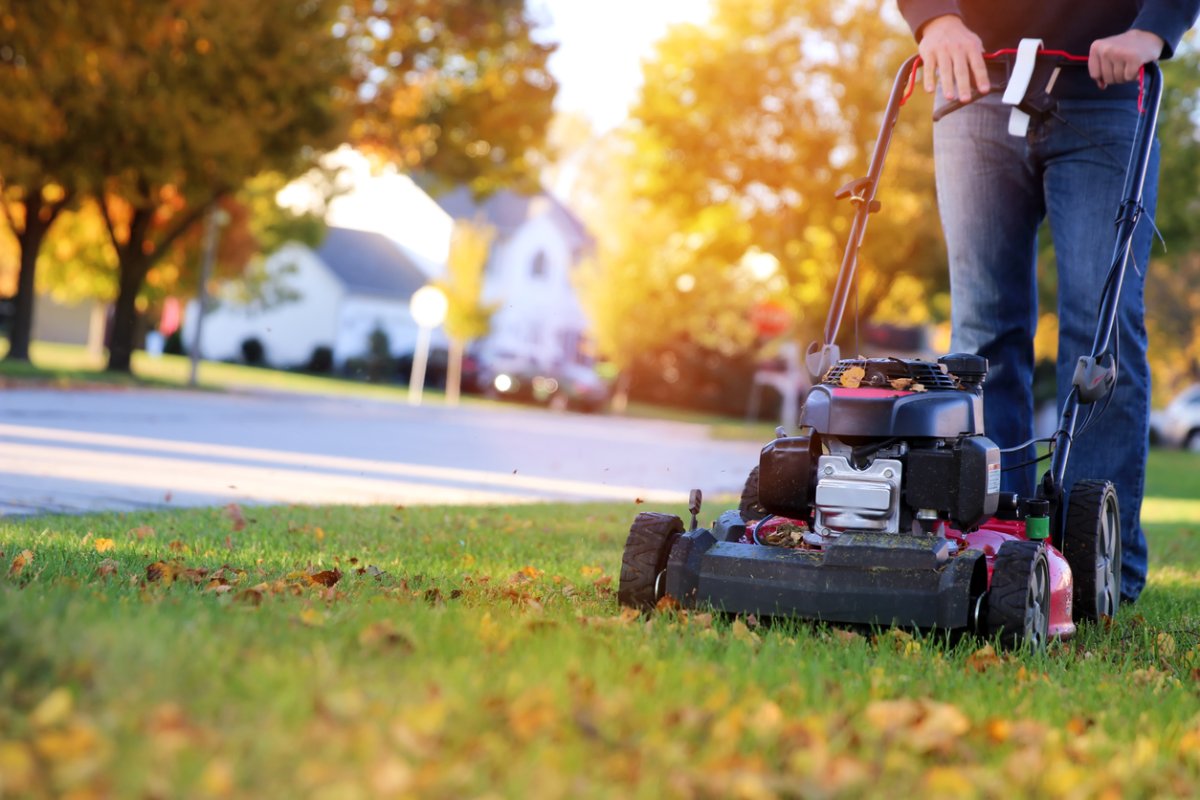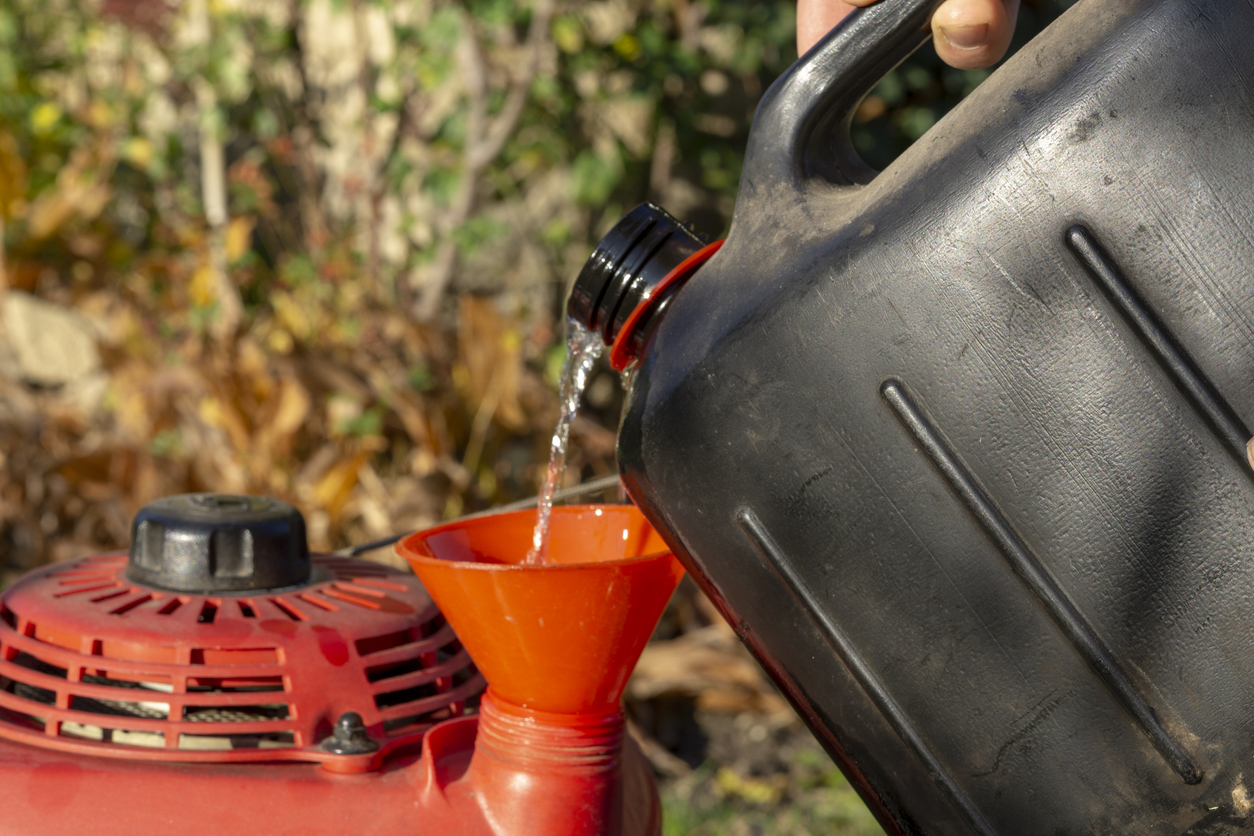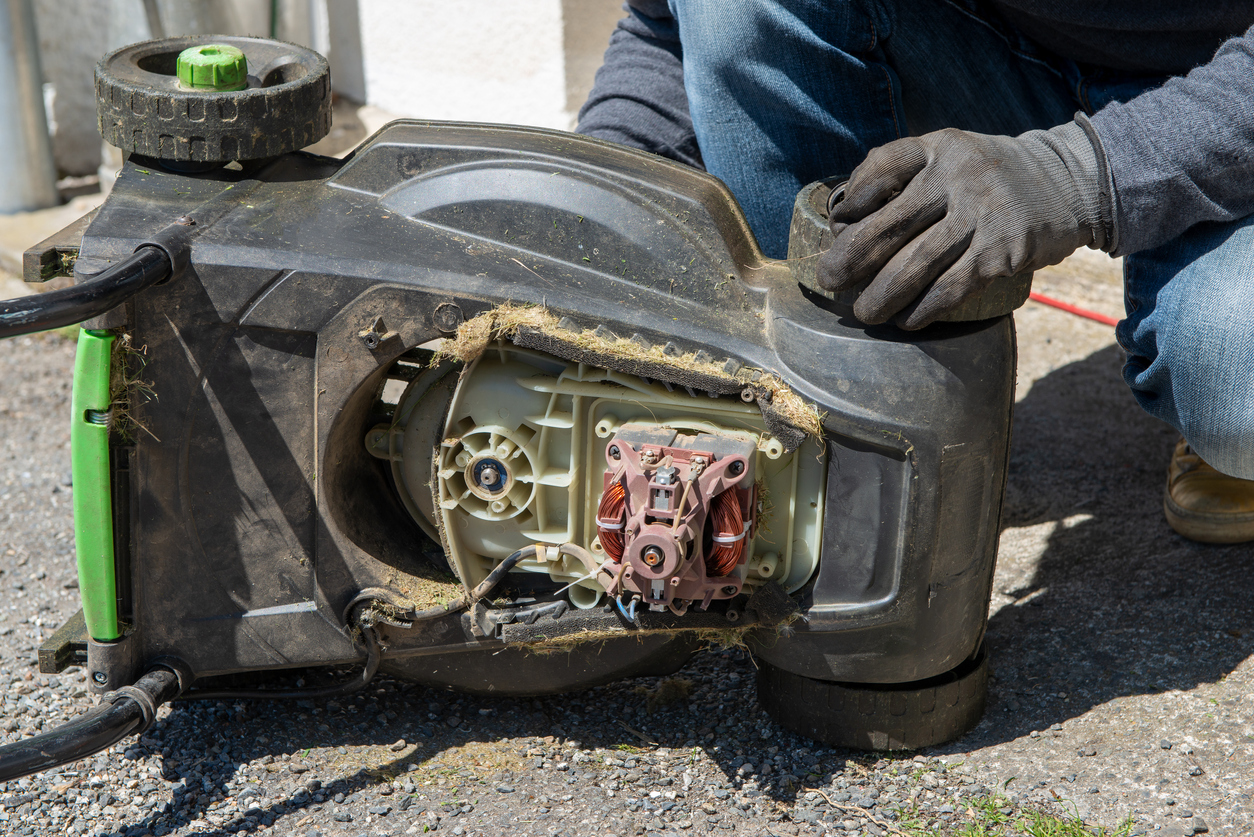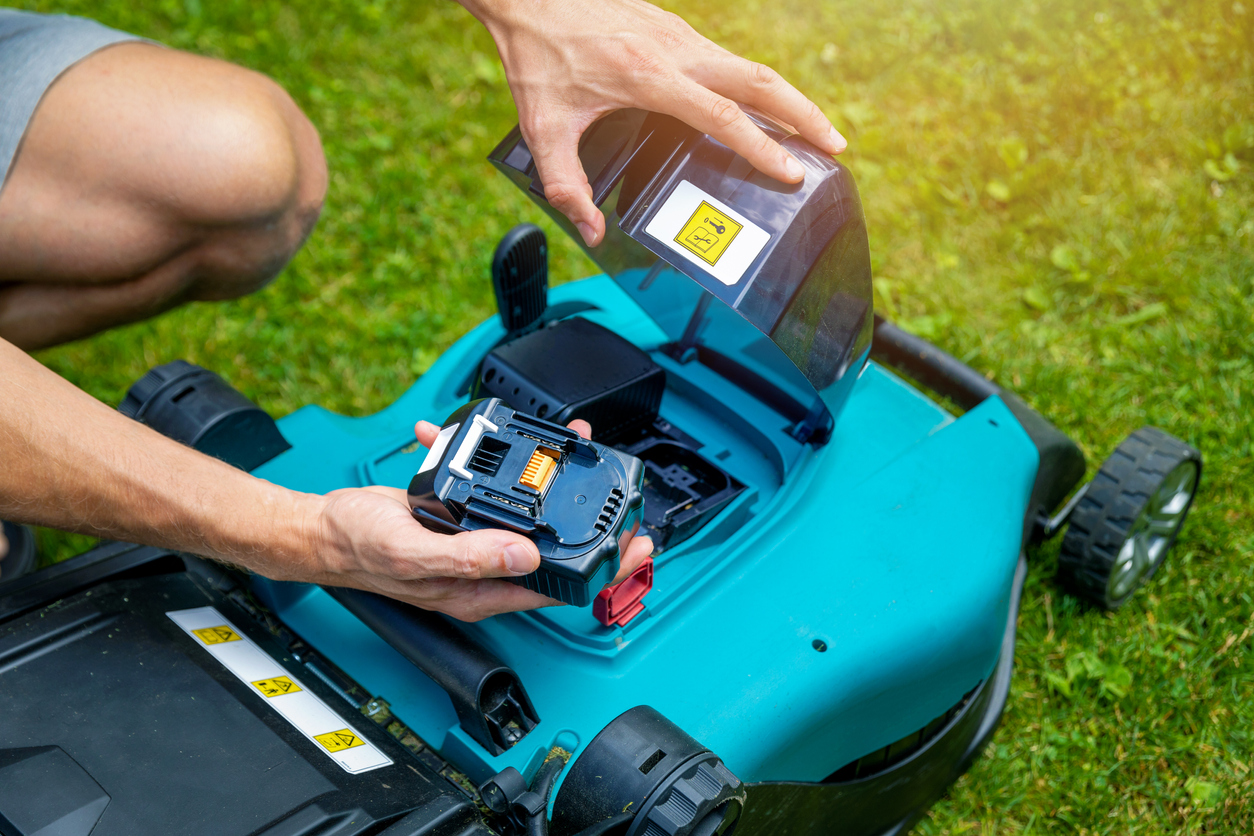

We may earn revenue from the products available on this page and participate in affiliate programs. Learn More ›
Winterizing a lawn mower is often overlooked, and then people wonder why it won’t start after sitting around all winter. That’s because a multitude of problems can begin while the machine is idle. Dirt and debris work their way into linkages and hoses, causing rust and seizures. Old fuel can damage the carburetor and engine.
By tackling a few quick and easy chores at the end of mowing season, the mower will be stored properly, and it can be ready to use as soon as the grass starts to grow next season. There is nothing here that requires a great deal of skill, and very few tools are needed. Keep reading to learn how to winterize a lawn mower and avoid potential problems.
Remove the spark plug or disconnect power.
Always think of personal safety first. It’s not unknown for a gas lawn mower to cough and splutter when it appears not to be running. It might only rotate the blade once or twice, but it can cause a serious accident if a hand is in the way. Similar problems can happen with a corded or cordless lawn mower if the power button is accidentally depressed.
Such incidents might be rare, but that doesn’t make them any less dangerous. People can lose fingers. So before you start any kind of cleaning or maintenance, remove the power source.
With a gas mower that means pulling the spark plug cable, or better yet removing the old spark plug altogether. When all of the tasks are completed, replace it with a new one. With electric lawn mowers, either unplug the power cord or remove the battery.
Related: After Testing More Than Two Dozen Popular Lawn Mowers, We Found the 9 Best Models
Empty the gas tank or stabilize the fuel.
Many people don’t realize that over time, gasoline actually goes bad. Normal usable life is three to six months. The decay process speeds up if it gets warm, like in the gas tank of a lawn mower on a hot day. As it ages, gasoline releases gummy substances that can clog the carburetor, exhaust port, and muffler. It also produces peroxides that attack rubber seals.
So when storing a lawn mower for winter, one of the most important jobs is to either drain the fuel completely or add a chemical stabilizer (available on Amazon). Most are compatible with standard fuels and those that have had two-stroke oil added, but it’s worth checking with the lawn mower’s specs to be sure.

Change the oil.
If you have a two-stroke lawn mower, lubricating oil is mixed with the gasoline and burns along with it, so this step isn’t necessary. If you have a larger four-stroke mower or lawn tractor, the motor will have a separate oil tank.
Motor oil is a surprisingly complex product, able to withstand extremes of temperature and pressure. However, while cooling and protecting the motor, it collects tiny particles of debris. As these particles build up they can start to cause wear, so the oil needs to be changed periodically.
Draining oil from lawn mower tanks is a simple task involving the removal of a drain bolt, collecting the old oil (and disposing of it responsibly), refitting the bolt and refilling it with oil of a grade recommended by the manufacturer. It’s a task usually best done about every 50 working hours. Typically it’s done in the middle of the season, and again at the end when the lawn mower is winterized.
Change filters.
Depending on the type of mower, there may be one or two filters. One in the fuel line, and in the case of four-stroke mowers, one for the oil tank.
Fuel filters are small, cylindrical objects often made of white plastic. They fit in the fuel line between the gas tank and carburetor, and they remove small particles of dirt from gasoline. Over time, this collected debris can restrict flow and begin to starve the motor of gas. They are held in place with simple clips that can usually be opened with ordinary pliers. Make sure to block off the fuel from the tank before doing so.
Oil filters do the same job of filtering gunk, but for oil instead of fuel. They are round metal objects that screw onto the side or underside of the motor. They can usually be removed by hand, twisting counterclockwise. Replacement is equally simple.
Related: The Best Riding Lawn Mowers for Hills, Tested and Reviewed
Sharpen the blade.
So far, most of the steps for lawn mower winter storage have been related to gas-powered mowers. Now we have several jobs that apply to all types. The first is sharpening the mower blade.
A dull blade might seem to cut, but it actually mashes the grass fibers. This damage hampers growth, and can allow diseases and causes patches of unsightly brown grass. A sharp blade cuts cleanly and helps keep the lawn healthy.
Sharpening can either be done with the blade on or off of the mower. A simple hand file can be used, but rotary tools with a grinding accessory are also popular. If you are sharpening on the mower, tilt it on its side rather than upside down, so metal filings don’t fall into the shaft that drives the blade.

Clean the deck.
The best policy is to clean the deck of a lawn mower every time it is used. It’s much easier to remove damp material than stuck-on, dried grass or dirt. If the deck is made of metal, cleaning prevents moisture from attacking the finish and starting corrosion.
Winterizing a lawn mower is a good opportunity to give the deck a thorough clean and check for damage. Lean the mower on its side, making sure it is stable and can’t tip over. Use wheel ramps with riding mowers, and chock the wheels. Never use jacks alone because they can topple over. For cleaning, use a pressure washer or a garden hose with an all-purpose cleaner and a stiff nylon brush.
Clean and lubricate moving parts.
There are two aspects to cleaning and lubricating the moving parts. Your owner’s manual may have lubrication advice, which should always be followed in order to extend the life of your machine.
Mowers have a variety of places in which dirt can get trapped, causing damage and the start of corrosion. Wheels and axles are typical locations. Levers that adjust speed or raise and lower the deck height are another area. If the handle folds for storage, there’s a link that can trap grit. These may not be major problems, but over time they start to stick or grate and become a nuisance.
Clean thoroughly first, then apply a small amount of light machine oil. A 3-in-1 oil (available from Amazon) is typical. Silicon sprays like WD-40 are great for loosening tight nuts and bolts, but aren’t the best lubricant for this application because they go sticky and can trap dirt.
Check cables.
Throttle cables can get kinked and worn. There are usually guides that they rub against. Eventually they can rub through the protective coating and rust will start. If the guide is worn, replace it. It’s a quick and easy job and costs very little. If the throttle cable has started to fray, that should also be changed, because when the thin wires that make up the cable come loose, they will invariably stab you in a finger. Not a serious injury, but definitely not pleasant.
On electric mowers, carefully check the cable outer for any sign of damage. If there are cracks or splits, it should be changed. Exposed wires can cause short circuits that might trip breakers or prevent the lawn mower from working. There’s also a real danger of electric shock that could prove fatal. As a safety precaution, all electric garden equipment should be plugged into an outlet with a GFCI (Ground Fault Circuit Interrupter) fitted to prevent this.
Related: 16 Simple Tricks to Stay Seriously Warm This Winter

If there’s a battery, remove it and store it indoors.
The final task that will winterize a riding mower or a cordless model is to remove the battery. There are two reasons for this.
First, both standard 12-volt vehicle batteries and lithium-ion types gradually drain if left connected. Second, cold weather saps the power from them, so batteries need to be kept at a temperature above 40 degrees Fahrenheit. If you store your lawn mower somewhere that drops to freezing, the battery ought to be kept elsewhere.
With 12-volt models, it’s a good idea to leave them on a trickle (or maintenance) charge. Most modern battery chargers will do this without causing damage. Lithium-ion batteries are best stored with a charge of around 40 to 50 percent. This can be difficult to judge, but many have charge indicators.
While winterizing the lawn mower, it may be time to think about how to store grass boxes during the winter. Canvas models make a great winter home for rodents (which will probably chew them to pieces), and snakes, so it’s a good idea to store them where wildlife can’t get to them.
